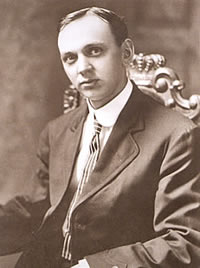Born in Kentucky 1877, Edgar Cayce was known as “the Sleeping Prophet,” because he uttered predictions and medical cures while in a deep trance. Until his death in Virginia, 68 years later, Cayce dictated thousands of “life-readings” he allegedly obtained from a kind of spiritual record he claimed to be able to read while experiencing an altered state of consciousness. Until his 47th year, he never uttered a word about Atlantis. But in 1922, he suddenly began recalling life in a place with which he was otherwise allegedly unfamiliar. Cayce said that his trance statements should be taken into account only to the extent that they led to a better life for the recipient. Moreover, he invited his audience to test his suggestions rather than accept them on faith. Other abilities that have been attributed to Cayce include astral projection, prophesying, mediumship, viewing the Akashic Records or "Book of Life", and seeing auras. Cayce said he became interested in learning more about these subjects after he was informed about the content of his readings, which he reported that he never actually heard himself.
Cayce’s descriptions of the doomed civilization are sometimes remarkable for their uncanny credibility. For example, his portrayal of the migration of Atlanteans into the Nile Valley following the destruction of their Empire is entirely convincing. Many otherwise obscure names of persons and places he associates with the Atlantis experience likewise seem to reflect real events. His son, Hugh Lynn Cayce, knew his father “did not read material on Atlantis, and that he, so far as we know, had absolutely no knowledge of the subject.” The evocative, often verifiable detail of his readings in which Atlantis was described is all the more astounding when we realize he knew little about the vanished culture in his waking hours. As his son wrote: They are the most fantastic, the most bizarre, the most impossible information in the Edgar Cayce files. If his unconscious fabricated this material or wove it together from existing legends and writings, we believe that it is the most amazing example of a telepathic-clairvoyant scanning of existing legends and stories in print or of the minds of persons dealing with the Atlantis theory.
Edgar Cayce’s conscious ignorance of the sunken civilization is not surprising. His formal education was meager, and his points of reference were more spiritual than historical or academic. His grasp of the past was often biblical, rather than scholastic. It seems clear then, that the subject was outside the purview of both his background and essentially Christian view of the world. But his readings are selfevidently plausible, because they often contain information that made little or no sense at the time they were uttered, but have been since confirmed by subsequent verification.
Perhaps most impressive of all is that obscure, even fleeting, references he made to Atlantis during the early 1920s were occasionally repeated only once, but within an exact same frame of reference, after more than two decades. Persuasive as these give even skeptics pause, and encourage many investigators, regardless of their spiritual beliefs, to reconsider everything he had to say about Atlantis. His prediction of finding its first physical remains not far from the United States was a case in point described in the “Bimini” entry. Until Cayce spoke of Bimini, and even long after some of his “life-readings” were published, no researchers bothered to consider that small island as a possible remnant of Atlantean Civilization. But how did the massive stone structure come to lie at the bottom of the sea? According to Cayce’s “life-readings,” the Atlantean lands underwent three major periods of inundation. They did not disappear altogether in a single cataclysm. The natural disaster described by Plato represented only the final destruction of Atlantis.
Read more on The Sleeping Prophet


No comments:
Post a Comment